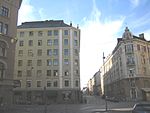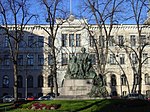Punavuori

Punavuori (Swedish: Rödbergen) is a neighbourhood in the center of Helsinki, the capital of Finland. The name Punavuori (English: Red mountain) refers to red cliffs located between Sepänkatu and Punavuorenkatu. They were still visible in the 19th century, nowadays they are covered with buildings and pavement. Punavuori was traditionally a working-class neighbourhood, today it is known as a bohemian district popular among artists, students and hipsters. It is one of the most densely populated areas in Finland. After the new location and growth of Helsinki in the 18th century, Punavuori became the area next to the center. During the 19th century the district had a seedy reputation. Most of the brothels and beerhouses were found in Punavuori. The social problems were aggravated by quickly built rent-apartments for the poor. After World War II, the district went through a process of gentrification. Today Punavuori offers many trendy small shops and bars, nightclubs and restaurants. Important streets include Uudenmaankatu and Iso Roobertinkatu. In the old Helsinki slang, the district is called "Rööperi" (derived from the district's Swedish name).
Excerpt from the Wikipedia article Punavuori (License: CC BY-SA 3.0, Authors, Images).Punavuori
Iso Roobertinkatu, Helsinki Punavuori (Southern major district)
Geographical coordinates (GPS) Address Phone number Website Nearby Places Show on map
Geographical coordinates (GPS)
| Latitude | Longitude |
|---|---|
| N 60.161666666667 ° | E 24.938055555556 ° |
Address
Liiliz studio
Iso Roobertinkatu 44
00120 Helsinki, Punavuori (Southern major district)
Finland
Open on Google Maps











